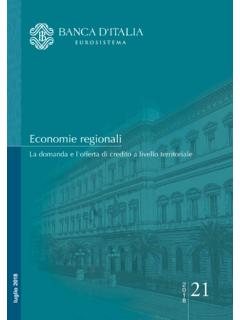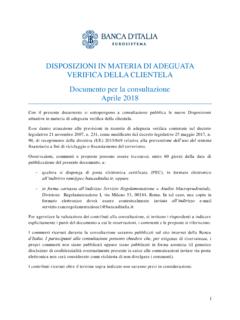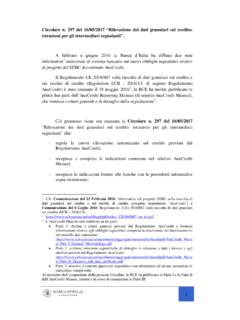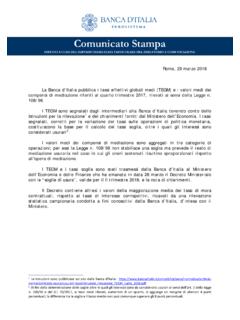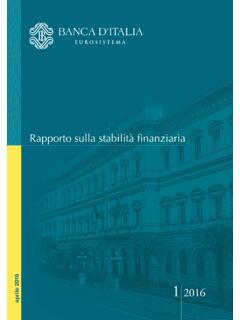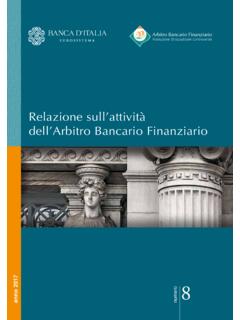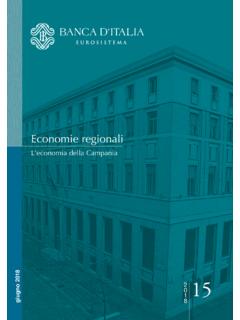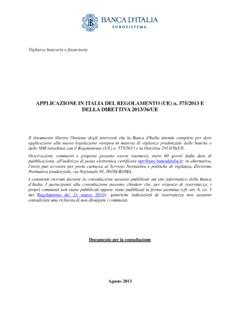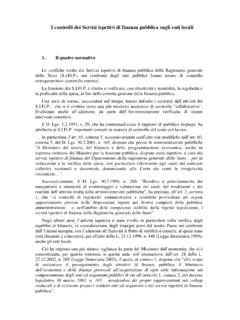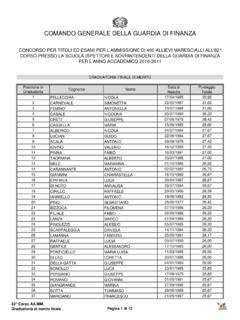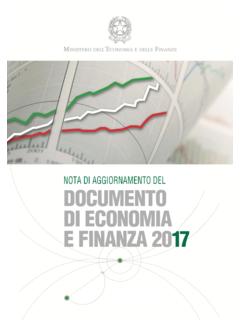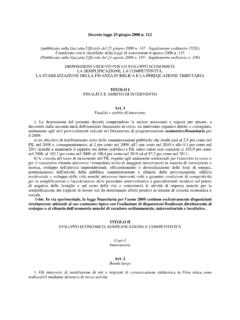Transcription of uestioni di Economia e Finanza - bancaditalia.it
1 Questioni di Economia e Finanza (Occasional Papers)Italian banks and market-based corporate financingby Giorgio Albareto and Giuseppe MarinelliNumber432 March 2018 Questioni di Economia e Finanza (Occasional Papers)Number 432 March 2018 Italian banks and market-based corporate financingby Giorgio Albareto and Giuseppe MarinelliThe series Occasional Papers presents studies and documents on issues pertaining to the institutional tasks of the Bank of Italy and the Eurosystem. The Occasional Papers appear alongside the Working Papers series which are specifically aimed at providing original contributions to economic Occasional Papers include studies conducted within the Bank of Italy, sometimes in cooperation with the Eurosystem or other institutions. The views expressed in the studies are those of the authors and do not involve the responsibility of the institutions to which they series is available online at.
2 ISSN 1972-6627 (print)ISSN 1972-6643 (online)Printed by the Printing and Publishing Division of the Bank of ItalyITALIAN BANKS AND MARKET-BASED CORPORATE FINANCING by Giorgio Albareto* and Giuseppe Marinelli* Abstract The recent financial crisis has induced firms to turn increasingly to financing sources other than bank credit, and banks to boost their income from non-lending services. This paper examines the placement market for Italian corporate securities and finds that it offers Italian banks considerable opportunity for expansion as their current share amounts to a third of total placements. In the last decade the ratio of total placement fees to total interest income of Italian banks slightly rose. Returns diminished progressively until 2008 and were then virtually unchanged in the following years; the decrease was less than that in returns on loans or on securities holdings.
3 When firms entered the stock and bond markets, bank credit was partially crowded-out and interest rates dropped for both first-time issuers and risky firms. However, when banks also played a major role both in placing corporate issues and in financing corporate issuers, lending relationships did not weaken. JEL Classification: G21, G24, G30, G32. Keywords: stock and bond issues, securities placement, banks profitability, corporate financing. Contents 1. Introduction ..5 2. The literature ..5 3. The market for placement of corporate securities issues ..7 An international comparison ..7 The Italian market ..9 4. Issuers and bookrunners: characteristics and matching ..11 5. Returns on placement services provided by Italian banks ..12 6. Access to capital market financing and credit relationships.
4 17 7. Conclusions ..23 Statistical appendix ..25 References ..33 Methodological _____ * Bank of Italy, Directorate General for Economics, Statistics and Research Statistical Analysis Directorate. *The recent financial crisis has highlighted the flaws of a corporate financing model centred largely on bank credit, pointing to a need for action on two fronts: firms should turn more to the market as a source of finance and banks should seek alternative sources of income to lending. Thus, banks and firms share a common interest: banks could increase their supply of financial services to firms and broaden their sources of income, while firms could diversify their sources of financing by entering the financial markets (Panetta, 2013; Rossi, 2013; Signorini, 2015). To assess how realistic this scenario is, on the bank side we need to analyse the profitability (direct benefits) and the effect on lending of supplying such services (indirect costs and benefits).
5 This paper provides some evidence on the banks offering of financial services to firms that will be useful in assessing whether such a scenario is likely to take hold over the next few years. Our analysis focuses on the placement of stocks and bonds issued by Italian firms, which accounts for the largest share of financial services to the corporate sector. The literature on investment banking tends to consider the viewpoint of firms, as the short survey in the next section illustrates. This paper instead looks at the question from the banks side, quantifying the direct benefits (profitability) and the indirect costs and benefits for banks (effect on lending) of placing corporate issues. A comprehensive assessment should take account of the indirect benefits of establishing new credit relationships with the firms using placement services, as well as of improving corporate financial soundness, earning capacity and growth prospects, potentially leading to a broader offering of products and services.
6 Moreover, providing securities placement services is less demanding in terms of capital absorption and may therefore be a good solution in times of tighter prudential requirements. The paper is organised as follows. Section 2 contains a brief overview of the literature. Next, after describing how securities placement services have developed in Italy over the last years, including in comparison with the leading economies, we look at the characteristics of the banks offering such services, the firms using them, and the relationship between the two. To conclude, we offer some elements for assessing the advantages for banks of expanding their supply of services to the corporate sector: we examine the return on supplying such services and compare it with the return on other types of banking activities, assessing the potential cost of weakening credit relationships with corporate issuers.
7 LiteratureThe literature on investment banking1 privileges the point of view of the corporate sector over that of the banks. Some research from the United States examines the possibility of commercial banks engaging in investment banking (Puri, 1996 and 1999; Gande, Puri, Saunders and Walter, 1997; Narayanan, Rangan and Rangan, 2001). The advantages of doing so lie in the economies of scope realised in collecting information on individual clients for use in both lending and placement activity. Against these advantages, if commercial banks were to provide underwriting services, which are a normal adjunct of placement, conflicts of interest could arise from the incentive to make improper use of proprietary information: a bank might 1 This includes securities placement. 5* We thank Massimiliano Affinito, Andrea Brandolini and Riccardo De Bonis for their comments on a previous draft of this paper.
8 Further its own interests by asserting that a firm with poor prospects is of good quality, underwriting its securities and selling them to clients;2 alternatively, it could grant investors loans to use in order to prop up the issue price of securities; finally, a bank might only grant finance or negotiate a favourable interest rate if the firm uses its underwriting services. Other studies have looked at whether the terms and conditions of placement services depend on the type of agent (investment bank, commercial bank or securities house). They examine the effects of lending, and its information content, on the terms of underwriting services and on a firm s choice of bank (Hamao and Hoshi, 2000; Guazzarotti, 2002; Yasuda, 2005; Drucker and Puri, 2005). Drucker and Puri (2005) show that if firms use the same bank for loans and for placement and underwriting services, they pay less in fees and commissions and the interest rates on loans are lower than for an equivalent amount granted by banks not offering such services.
9 This is because of the information-related economies of scope associated with combining financing and placement/underwriting. Firms with greater leverage and a lower credit rating benefit the most from the potential efficiency gains of using the same bank for borrowing and for capital market access. Several studies have found that reputation is a key factor in the issuer s choice of issue manager. Johnson and Miller (1988) and Carter and Manaster (1990) empirically test a theoretical model in which that choice sends a signal to the market: banks of better reputation signal lower-risk issuance, which has advantages for the firms in fixing the issue price. Later studies have noted that the long-term performance of corporate issuers is positively correlated to the reputation of the banks they use as issue managers (Carter et al.)
10 , 1998; Carter et al., 2010). Jones and Swaleheen (2010) take these results one step further, making the choice of bank an endogenous variable linked to the characteristics of the issuer: less (more) risky issuers use banks with a better (worse) reputation. Access to capital market financing may supplant bank credit for firms. Some studies have examined the substitution and complementarity between capital market financing (bond issues in particular) and bank loans, which may help in assessing the indirect costs and benefits of banks acting as issue managers. For Italy, Panetta (2001) looks at the evolution of the cost and quantity of credit used by a group of firms issuing euro-bonds for the first time, concluding that bond finance and bank credit are complementary. Finaldi Russo and Guazzarotti (2014) show that during the crisis the possibility of accessing the bond market allowed corporate issuers to eliminate a substantial part of their bank debt.
